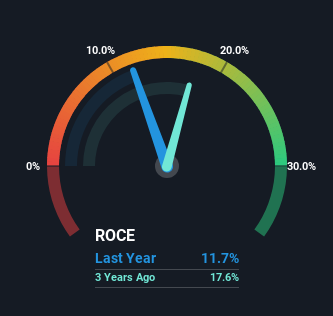
If you're looking for a multi-bagger, there's a few things to keep an eye out for. Firstly, we'll want to see a proven return on capital employed (ROCE) that is increasing, and secondly, an expanding base of capital employed. This shows us that it's a compounding machine, able to continually reinvest its earnings back into the business and generate higher returns. With that in mind, the ROCE of SIS (NSE:SIS) looks decent, right now, so lets see what the trend of returns can tell us.
What Is Return On Capital Employed (ROCE)?
Just to clarify if you're unsure, ROCE is a metric for evaluating how much pre-tax income (in percentage terms) a company earns on the capital invested in its business. The formula for this calculation on SIS is:
Return on Capital Employed = Earnings Before Interest and Tax (EBIT) ÷ (Total Assets - Current Liabilities)
0.12 = ₹4.1b ÷ (₹60b - ₹25b) (Based on the trailing twelve months to December 2023).
So, SIS has an ROCE of 12%. In isolation, that's a pretty standard return but against the Commercial Services industry average of 18%, it's not as good.
View our latest analysis for SIS

Above you can see how the current ROCE for SIS compares to its prior returns on capital, but there's only so much you can tell from the past. If you're interested, you can view the analysts predictions in our free analyst report for SIS .
What Does the ROCE Trend For SIS Tell Us?
While the returns on capital are good, they haven't moved much. Over the past five years, ROCE has remained relatively flat at around 12% and the business has deployed 81% more capital into its operations. Since 12% is a moderate ROCE though, it's good to see a business can continue to reinvest at these decent rates of return. Over long periods of time, returns like these might not be too exciting, but with consistency they can pay off in terms of share price returns.
On a side note, SIS' current liabilities are still rather high at 42% of total assets. This effectively means that suppliers (or short-term creditors) are funding a large portion of the business, so just be aware that this can introduce some elements of risk. While it's not necessarily a bad thing, it can be beneficial if this ratio is lower.
The Bottom Line
The main thing to remember is that SIS has proven its ability to continually reinvest at respectable rates of return. However, over the last five years, the stock hasn't provided much growth to shareholders in the way of total returns. That's why we think it'd be worthwhile to look further into this stock given the fundamentals are appealing.
One more thing, we've spotted 1 warning sign facing SIS that you might find interesting.
While SIS isn't earning the highest return, check out this free list of companies that are earning high returns on equity with solid balance sheets.
New: Manage All Your Stock Portfolios in One Place
We've created the ultimate portfolio companion for stock investors, and it's free.
• Connect an unlimited number of Portfolios and see your total in one currency
• Be alerted to new Warning Signs or Risks via email or mobile
• Track the Fair Value of your stocks
Have feedback on this article? Concerned about the content? Get in touch with us directly. Alternatively, email editorial-team (at) simplywallst.com.
This article by Simply Wall St is general in nature. We provide commentary based on historical data and analyst forecasts only using an unbiased methodology and our articles are not intended to be financial advice. It does not constitute a recommendation to buy or sell any stock, and does not take account of your objectives, or your financial situation. We aim to bring you long-term focused analysis driven by fundamental data. Note that our analysis may not factor in the latest price-sensitive company announcements or qualitative material. Simply Wall St has no position in any stocks mentioned.
About NSEI:SIS
SIS
Provides security and related services in India, Australia, Singapore, and New Zealand.
Excellent balance sheet and good value.
Market Insights
Community Narratives




